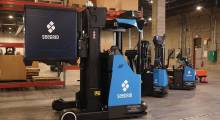Editor’s Note: The following column by Stevie Hay, senior director at Aptean, is part of Modern’s Other Voices column. The series features ideas, opinions and insights from end-users, analysts, systems integrators and OEMs. Click here to learn about submitting a column for consideration.
———
If there’s ever been proof of life after economic changes, this is it: a recent column in the Morning Call, an eastern Pennsylvanian newspaper.
In the piece, former Bethlehem, Penn., mayor Don Cunningham describes the awe he felt walking by the Bethlehem Steel factory in 1998, soon after the manufacturer declared bankruptcy. The factory shuttered division by division until it was a ghost of its former self. Cunningham remembers the uncertainty that swept the region. What would become of Lehigh Valley now that the blast furnaces were silent?
But the community didn’t give up; it reinvented itself and diversified its economy. Two decades later, Cunningham reports the area’s 2017 GDP reached $39 billion – higher than it was during the steel era.
With fulfillment on the cusp of its own radical transformation, how do we apply the lessons learned from Lehigh Valley to an industry increasingly driven by artificial intelligence? The answer: consider how you can make automation an opportunity for your employees, rather than a roadblock.
Tomorrow’s Warehouse: Robots in the Aisles
Although the idea of an automated warehouse conjures up images of robots managing every task while one or two humans oversee the process, it’s unlikely warehouses will achieve this level of automation soon. Because robots think in algorithms without the ability to analyze quality, they’re not ready for packing processes, where accuracy and attention to detail in package assembly are essential.
Instead, many warehouses are implementing robots in their picking processes – rote maneuvering through the warehouse, grabbing pre-determined items and delivering them to a set location. Today’s warehouse management systems can help employees adjust inventory layout for easier access to more popular items, but employees are still required to walk the aisles. With SKU locations programmed into a robot, humans can focus on more demanding warehouse tasks such as receiving, kitting, inventory control and inbound/outboard quality assurance.
In the debate around greater automation, two current forces work in an employee’s favor: (1) technology is evolving quickly, but not so quickly as to pose an immediate threat and (2) e-commerce is growing even quicker, increasing the need for more workers within distribution centers. In January 2017, Amazon announced it would add 100,000 jobs over the next 18 months in fulfillment centers across the country. Still, these jobs will demand a different skillset than warehouses required 10 or even five years ago. So how do we prepare employees to adapt?
New Roles in an Old Industry
For executives considering greater use of automation in their fulfillment operations, the key is openness with your employees and a vision focused on opportunity. Being more open, providing opportunities and training will lead to greater employee satisfaction and engagement. Companies spend approximately $7,000 to replace each employee; with the high turnover in warehouses, retaining employees would result in tremendous savings.
Consider these three steps to preparing your employees for the new warehouse:
Develop a plan and discuss your company’s intent. Your employees understand that change is coming. However, blindsiding them with layoffs or sudden changes in responsibility can damage the employee-manager relationship. As you complete long-term planning, allow employees the opportunity to provide feedback and help them understand what automation will look like in their environment. Explore opportunities to use employees in different ways or within different parts of the business while maintaining your costs per unit. Perhaps you can win more business with the same staff, rather than laying them off.
Promote departmental training sessions. For many employees, the shift from standard picking practices to working with servicing and programming robots will be jarring. Allow a set amount of paid time for employees to learn about your new technology and work through practice scenarios, and ensure all employees can attend at least one session.
Encourage/incentivize your employees to participate in professional development. You don’t need to wait until you’re ready to implement automation to retrain your employees. Consider offering a program that will pay some, or even all, of a professional development course for your warehouse staff. These incentives are win-win – your employees will be comfortable with change, and the knowledge they gain can drive both quicker implementation and more effective operation.
The Benefits of Embracing Change
When Lehigh Valley experienced the effects of a changing economy, it refused to permit a downward spiral of unemployment. Instead, it met new demands, trading the steel mill for manufacturing– a growing sector in the area, now worth $6.9 billion. Transportation and warehousing is the community’s fourth biggest employment sector. For workers willing to take on new roles in its distribution centers, the community can offer a living wage, and indeed, the local fulfillment industry is at full employment, according to the Morning Call piece.
The average warehouse worker may not face such a significant upheaval as the one seen at Bethlehem Steel. Still, the days of manual picking and inventory management are coming to an end, and Lehigh Valley demonstrates how a community can come together and adapt to changing conditions. As e-commerce continues to grow, so will job opportunities – just with a different set of descriptions. With some support from management, warehouse employees can face these changes with little fear of the future.








